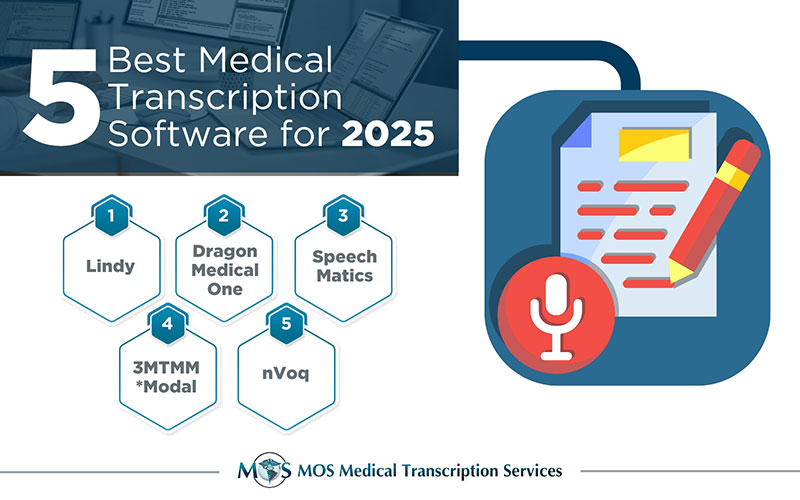
Table of Contents
The administrative strain of manual typing may overwhelm physicians and medical personnel. The 2023 Medscape Physician Compensation Report states that doctors devote 15.5 hours a week on average to paperwork and administrative duties. This study highlights how non-clinical responsibilities lead to physician stress and impair patient care by examining the scope of these loads across 23 medical disciplines. Medical transcription services can help with this.
Medical transcription outsourcing to reliable providers has long been the backbone of this process, converting physicians’ spoken words into accurate text records. With the advent of advanced technologies, especially artificial intelligence (AI), the landscape of medical transcription is evolving rapidly.
What Is AI-based Medical Transcription?
AI medical transcription is the process of mechanically turning spoken medical dictations into text using software driven by artificial intelligence. These systems accurately transcribe conversations between patients and healthcare practitioners using machine learning (ML) and natural language processing (NLP) algorithms, producing structured documentation either immediately after the contact or later. It is estimated that voice-enabled clinical documentation will save US healthcare providers over $12 billion a year by 2027.
When opposed to typing, applying voice recognition (SR) software for medical documentation saves time, according to a 2022 study published in the British Journal of Healthcare Management. Typing took 8.9 minutes on average, while SR took 5.1 minutes. Additionally, it generated 0.15 versus 0.3 mistakes per line. Although SR improves the speed of documentation, efforts may be required to allay doctors’ worries and foster their trust in the technology.
5 Best Medical Transcription Software for 2025
- Lindy: It is a 24/7 dedicated AI medical transcriptionist with over 99% accuracy, tailored to your specific vocabulary and clinical needs. Imagine dictating patient notes, consultations, or research findings and having them instantly converted into accurate, HIPAA-compliant transcripts—without lifting a finger. Lindy ensures precision by transcribing patient interactions and research notes with high accuracy, recognizing complex medical terminology and jargon. It’s ultra-personalized, allowing you to customize your own “Lindy Medical Scribe” to adapt to your voice, dictation style, and preferred medical terms for maximum accuracy. Security is a top priority, with HIPAA and PIPEDA compliance ensuring patient data protection through robust encryption. Seamless integration with EHR systems, other medical software, and additional Lindy features makes it easy to streamline workflows. Lindy’s flexibility extends beyond transcription, allowing you to combine its tools for enhanced automation—such as summarizing key points, generating follow-up emails, or even scheduling appointments and updating patient records.
- Dragon Medical One: Dragon Medical One by Nuance Communications is a speech recognition software designed specifically for healthcare professionals. It is tailored to recognize medical terminology and can adapt to individual voice patterns for improved accuracy. One of its standout features is ambient voice technology, which allows it to capture and transcribe conversations happening around the provider, making it useful for documenting patient interactions or multi-party discussions. Additionally, its AI-powered clinical documentation improvement (CDI) feature reviews clinical notes and suggests enhancements to ensure greater accuracy, completeness, and compliance with coding standards. Dragon Medical One also integrates with the Dragon Anywhere mobile app, enabling users to dictate and transcribe notes on the go—though it’s best not to use it while driving.
- Speechmatics: Speechmatics brings the power of AI to medical transcription with an impressive accuracy rate of up to 98%. Its software includes advanced features such as templates, macros, voice biometrics, and seamless EHR integration. One of its standout capabilities is the ability to create customizable language models tailored to specific medical vocabulary, significantly enhancing transcription accuracy. Additionally, Speechmatics offers real-time transcription, allowing users to see text appear as they speak, improving efficiency in fast-paced healthcare settings. For added flexibility, it also supports offline transcription, making it an excellent choice for situations where internet connectivity is limited or unavailable.
- 3MTMM*Modal: 3MModal provides AI-assisted speech recognition software for medical transcription, featuring auto-correction, templates, and seamless integration with EHRs for efficient workflows. In addition to its AI capabilities, 3MModal offers human transcription services for specialized needs. One of its standout features is Fluency Direct, a cloud-based speech recognition solution that delivers high accuracy and real-time feedback, enabling quick and efficient documentation. The Computer-Assisted Physician Documentation (CAPD) solution enhances clinical documentation by offering real-time prompts and suggestions to ensure completeness and accuracy. Additionally, 3MTMM*Modal’s clinical analytics tools help healthcare providers identify trends, patterns, and insights within patient data, supporting informed decision-making and improved patient care.
- nVoq: nVoq leverages advanced AI and machine learning to transcribe medical speech with an accuracy rate of up to 99%, offering features like voice navigation, macros, and seamless EHR integration while allowing user customization for personalized workflows. Its SayIt platform, a cloud-based speech recognition solution, enhances accuracy with personalized vocabulary and acoustic modeling tailored to individual voices. Additionally, nVoq’s speech-enabled automation streamlines various tasks within EHR systems and other applications through voice commands. The software also integrates with Dragon Medical One, combining the strengths of both platforms to deliver a more comprehensive and efficient transcription solution.

Drawbacks of AI-integrated Medical Transcription
As AI technologies continue to evolve, addressing key challenges is essential for their successful integration into healthcare. These challenges include ensuring transcription accuracy, protecting patient data, navigating ethical and legal concerns, and fostering user acceptance. Overcoming these obstacles requires ongoing algorithm refinement, robust security protocols, well-defined ethical frameworks, comprehensive training programs, and active involvement from healthcare professionals.
- Transcription Accuracy: While AI transcription has improved, it can still struggle with complex medical terminology, diverse accents, and speech nuances, leading to potential errors in documentation.
- Data Security and Privacy: Safeguarding sensitive patient information is critical, requiring strict compliance with healthcare regulations such as HIPAA.
- Ethical Challenges: The use of AI in healthcare raises concerns about patient consent, data ownership, and the role of automation in clinical decision-making.
- Implementation and Training: Effective adoption of AI transcription tools depends on proper training for healthcare providers and seamless integration into existing workflows.
- Legal and Liability Risks: Errors in AI-generated transcriptions could have serious legal implications, especially if they impact patient care decisions.
- User Adoption and Trust: Some healthcare professionals may be reluctant to embrace AI transcription due to concerns about accuracy, workflow disruptions, or potential job displacement.
Why Human-integrated Medical Transcription is Superior
While AI offers efficiency, human involvement remains crucial in medical transcription. Human transcriptionists possess contextual understanding, allowing them to interpret nuances, implied meanings, and medical jargon that AI might misinterpret, ensuring comprehensive and accurate records. Additionally, human oversight provides a critical layer of quality assurance, as professionals can review and correct errors that AI-driven systems might overlook. Ethical considerations also play a vital role-human professionals handle sensitive patient information with the discretion and empathy required in healthcare settings. So, while AI has significantly enhanced the efficiency of medical transcription services, the integration of human expertise ensures the highest standards of accuracy, empathy, and ethical responsibility in patient care documentation. The medical transcription industry is also transforming to provide the best services and safeguard patient safety.


